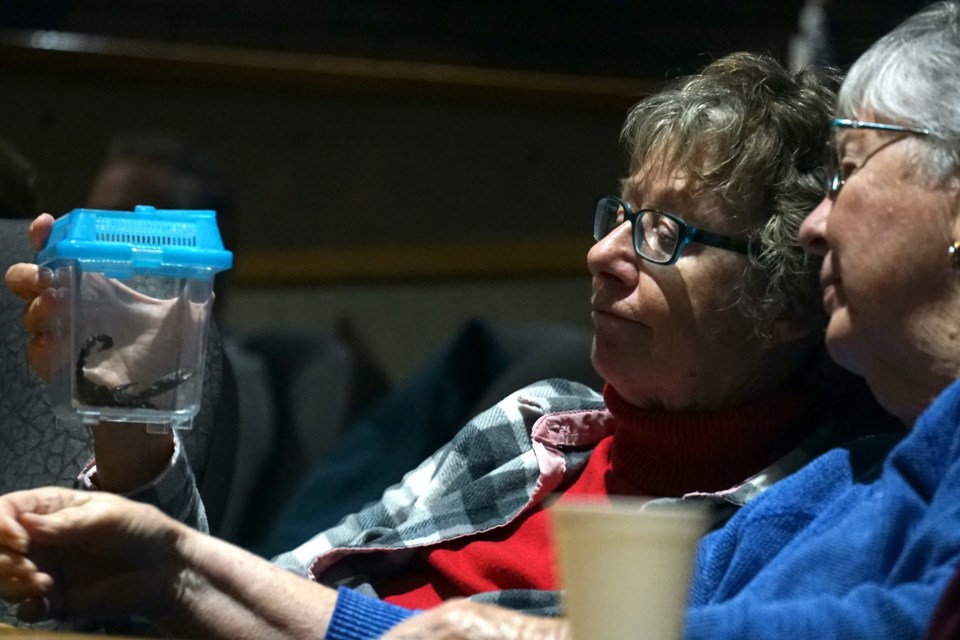ATHABASCA — Science lovers and life-long learners were treated to a Dr. Robert Holmberg ‘signature’ presentation as Science Outreach Athabasca returned to Athabasca University (AU) for the first time since the COVID-19 pandemic.
Twelve in-person attendees — and 5 virtual guests — gathered in the AU Governing Council Chambers on the evening of Oct. 26 to take part in the “Chelicerates: arachnids and their relatives” presentation by Science Outreach Athabasca co-founder and retired AU professor Dr. Robert Holmberg.
“These are my favourite animals — I think everybody should love them,” said Holmberg after the presentation. Holmberg has given more than 300 lectures on arthropods, or crawling invertebrates since 2000, and credits a job he took during his time at the University of Saskatchewan for sparking his interest in spiders and their relatives.
“I couldn’t find a job, so I did a masters, and then I had a choice; I decided to either do the defensive glands of millipeds, or the defensive glands of daddy long legs, and I’m glad I chose daddy long legs, because there’s very few millipedes in Saskatchewan,” Holmberg said with a laugh.
The presentation reviewed 12 different species of chelicerates, their biology, and their economic and ecological importance. A chelicerate is an animal that is bilaterally symmetrical, has no antennae, and feature a single layer of hard epidermis, also known as an exoskeleton.
Approximately 137,000 species of chelicerates have been scientifically identified and described, which Holmberg said is a relatively small number. “That’s only probably 17 per cent of what is actually out there, as opposed to mammals, where there’s about 500,500 species and we’ve probably described at least 98 per cent.”
Holmberg discussed four main groups of the subphylum chelicerata, which include sea spiders, horseshoe crabs, sea scorpions, and spiders; or pycnogonids, xiphosurans, eurypterids, and arachnids for the more science-minded readers.
Multiple specimens were passed around the chambers as Holmberg described the different species, many collected by Holmberg himself, with collection dates ranging back to 1983. The presentation also featured two live tarantulas and a live scorpion — the animals remained inside plastic containers as they were passed amongst attendees who wanted a closer look.
Arachnids are the most numerous of the chelicerates, accounting for around 135,000 of the 137,000 described species, which includes mites, spiders, and scorpions. Common examples of arachnids include hair follicle mites, which Holmberg said are present on almost everyone, transferred by mothers during infancy.
Other arachnids found in Alberta include black widow spiders and wind scorpions — which are neither scorpions or spiders — typically found in southern parts of the province. Parasitic moose ticks are also found in Alberta, and feed on the blood of moose. Symptoms of a moose tick infection can include significant hair loss in animals, which can lead to death by hypothermia during cold springs.
House dust mites, which feed off dead human skin cells, and cheese mites that produce distinct flavours in different cheeses are other common microscopic roommates most people would rather not think about.
Holmberg’s presentation was followed by a question and answer period and draws for five door prizes — one of which was giant motion-activated plush spider, a perfect decoration for Halloween.
Linda Labelle, coordinator for Science Outreach Athabasca, said she was happy with the result of the first in-person presentation at AU since 2020, and is optimistic about the new hybrid delivery model.
“I think it went fairly well, it’ll take time for people in the community to come back out and start to learn about science again and be comfortable to do that in-person. But if they’re not comfortable coming in person, they’re always welcome to stream it live.”
The next science outreach event will be a follow-up Permaculture and Alternative Power tour held Nov. 9 at River Myst Ranch outside of Caslan. The tour will run in the afternoon, and guests are encouraged to bring their own mug for hot drinks.



